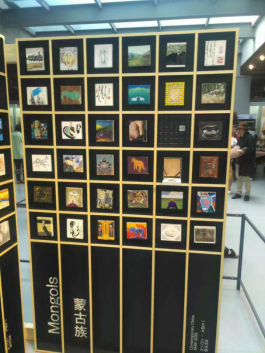By Tom McGregor, CCTV.com Panview commentator and editor
The people from Inner Mongolia Autonomous Region are recognized as rugged individuals, since many families there hail from nomadic backgrounds with ancestral claims, directly or indirectly, connected to the legendary Mongolian ruler Genghkis Khan of the 14th Century.
Inner Mongolia is a land of frigid winters with large swathes of grasslands that are flat and barren, while Hohhot, capital of Inner Mongolia, is surrounded by mountains.
The residents of Hohhot and the surrounding area take pride in their horses, sheep-grazing and physical strength. Nonetheless, Inner Mongolia has a soft side too, since artists have earned respect in the local community.
Local artists have even captured the eyes of the world-renowned Luciano Benetton Collection and German auto manufacturer BMW, who are sponsoring an exhibit in Hohhot.
Miniature art on display
On Sunday, July 9, the 'Colorful China' national art exhibition of miniatures to celebrate 'Imago Mundi Contemporary China' was opened at the Hohhot Urban District Culture Art Center, with over 3,900 artworks scheduled to go on display from July 9-August 15.

'Colorful China' national art exhibition of miniatures opened at Hohhot Photo by Ormus Sodhuu
The exhibit features paintings from artists not only from Inner Mongolia, but from other parts of China and 23 countries. But you may wonder, how can you display over 3,900 paintings in a medium-sized museum?
Well, the Luciano Benetton collection sent a tiny 10-cm.-by-12.cm frame to all artists invited to participate. If an artists wished to submit a piece they could only paint in the small frame. Larger art works were forbidden.
The guidelines disappointed a few Inner Mongolian artists, since they live in large open spaces, and are prone only to think big when creating art.
Big vs. Small debate
A day prior to the art exhibit's opening ceremony, Yan Zhijie, chief artistic director of 'Imago Mundi Contemporary China,' hosted a forum for regional artists to meet Luciano Benetton and his team from Italy.
They also had a debate: Big vs. Small artworks.
"I have a few artist friends and when they received the tiny frame and told the rules, they refused to submit any art," said Xing'an, an Inner Mongolian artist.

Artist Xing'an working on his painting Photo by Ormus Sodhuu
He added, "A few artists are famous here, but they don't like to do small paintings. They paint big or not at all. That's because some artists lose confidence if they must paint in a small frame."
Other artists, who were in attendance, said big paintings are important for ethnic-Mongolians, since they prefer painting horses and landscapes.
Supporting small-size
Nevertheless, many artists and experts supported the requirement to paint on a small frame. The organizers insisted this gave greater opportunities for more artists to get display their artworks.
The more who participate, the better the chance of an unknown artist with special talent can get recognition from the public and the Luciano Benetton Collection, said one organizer from Beijing.

Miniature artworks by Mongolian artist at display Photo by Ormus Sodhuu
Other artists argued that the small frame makes every space more valuable. They must use every centimeter for artistic value. You also get an idea if the artist has talent, just by reviewing it in a small-scale.
Luciano Benetton told the story of his good friend, an artist, who was struck by illness and old age. He could no longer paint, but Benetton continued to request new paintings from him.
His friend's solution: He found one of his big paintings, took a photograph, attached it to a frame and send it too him. Accordingly, that’s how Benetton got the idea to ask artists to paint on a small-frame.
Art is the answer
"An artist can find many ways to do art," Benetton said. "Even when they have strict restrictions or lose the physical ability to do it, they can find a way."
A number of artists from Inner Mongolia and other parts of China had expressed their support for the guidelines.
They welcomed an opportunity to submit artwork that would be closely observed by art collectors and experts from Italy. For them, art is not about pursuing wealth and fame but to tell their story to the world with a paintbrush.
A local designer from Hohhot gave a speech to describe how he values art. He said, "The visual in art is so important for the eyes and art connects with the eyes."
He added, "The image can help you, the viewer, since it has so much meaning to open your mind. To do art, you are free."
Opening Inner Mongolia to the world
The Inner Mongolian people live in a sparsely-populated landscape. Hence by living in isolation, regional artists lack opportunities to garner global fame even if their talent justifies it.
The opening of the art exhibit provided them a chance for glory and to meet the major players of art in Italy, which includes: Luciano Benetton, the President of Benetton Study Research Foundation, Mr. Adriano Madaro, Curator of Exhibition, Author, Professor of Chinese History and Mr. Mario Ona, the consultant of Benetton Group.
Ethnic artists, such as the Mongols and Daur, were the prominent artists who had their artworks on display. The Mongols are warriors at heart and they have proven to hold a passion for art as well.
(The opinions expressed here do not necessarily reflect the opinions of Panview or CCTV.com)

Panview offers a new window of understanding the world as well as China through the views, opinions, and analysis of experts. We also welcome outside submissions, so feel free to send in your own editorials to "globalopinion@vip.cntv.cn" for consideration.
















